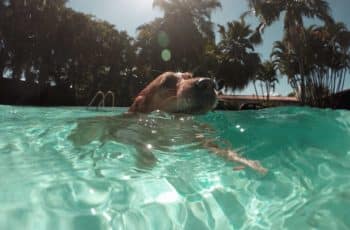There’s something magical and memorable about dogs and the beach. Watching your dog’s paws racing through the sand and exploring the water is enough to make any dog parent’s heart soar. As inviting as it is, the beach also poses some terrifying safety hazards to dogs.
Dog dad Robert Summerill took his small mixed breed go, Abbi to the beach for a day of fun. The dedicated pet parent had no idea he would soon be rushing his dog to the veterinarian. Summerill spent the day tossing a tennis ball to his eager pooch. Each time she scooped the ball up with her mouth, she also took in sand.
After bouts of diarrhea and vomiting later that day, the Maltese mix ended up needing emergency care. She was examined, and there was no major sand impaction in her organs. She cleared the sand with bowel movements tainted with blood and sand.
Sand ingestion is but one of the many terrifying dangers facing dogs and the beach. In this article, we’ll share expert safety tips and dangers to avoid for both you and your canine best friends.
Some of the links in this article are affiliate links. As an Amazon Associate, I earn from qualifying purchases. I am also an Etsy and Chewy affiliate.
Dogs and the Beach Top 20 Safety Hazards
No one wants to be a party pooper when it comes to making memories with your dog on the beach. An ounce of prevention, however, goes a long way in avoiding emergency room visits with your dog. Be proactive and keep these 20 beach safety hazards in mind (with bonus fun later in this article.)
Ingesting Too Much Ocean Water
Ocean water is high in salt content. While small amounts may cause your dog to be thirsty, you don’t want your dog ingesting ocean water. Take frequent breaks from ocean play so your dog does not have the opportunity to drink the water. Some pet parents use a comfortable basket muzzle at the beach so their dog has fun and can breathe freely without the fear of ocean water ingestion.
Dehydration
Along with ingesting too much ocean water comes the risk of dehydration. Swallowing enough of it can lead to serious problems. Have plenty of cool, clean water available so your don’t isn’t tempted to drink from the ocean.
Signs of severe dehydration include vomiting and trouble walking, so rush your dog to a veterinarian if that happens.
Sand Fleas on Dog
Despite its insect-like name, sand fleas are tiny crustaceans in the same family as lobsters and crabs. While some sand fleas are harmless, the Cleveland Clinic says others can burrow into your skin or that of your dog and cause problems. Sand fleas are not sand flies, either, to further mess with a day at the beach.
Sand flea bites cause raised, red lumps, itchy skin, and inflammation. Use proper insect repellants that are safe for you and your dog. Here are our favorite non-chemical flea and tick repellants.
Rough Current or Choppy Waters
Even the most adept canine swimmers can be carried away by strong currents, a strong undercurrent, choppy waters, or intense waves. Consider a life vest if your dog gets tired and assess water conditions before allowing your dog to enter the ocean.
Jellyfish Dangers
Our friends at Gulf Coast Cocker Spaniel Rescue witnessed one of their dogs getting stung by a jellyfish at the beach. During a morning stroll on the beach, the dog stepped on a washed-up jellyfish, which then stung the pooch. Be sure to pay attention to where your dog walks and have a first aid kit, with jellyfish sting emergency items, too!
Sea Glass and Shoreline Dangers
It used to be that sea glass and broken shells were the most dangerous items strewn along the ocean’s shoreline. A dog in San Diego recently ingested drugs at the Dog Beach at Ocean Beach. Kelly Wiehe’s 4-year-old Labrador gobbled something up before she could stop her. Sadly, the dog got sick and tested positive for marijuana, Ritalin, and methamphetamines. Keep a close eye on your dog for any sort of items that could damage paws or be ingested.
Shells, crab legs and dead creatures are fun to lick and play with, but could cause bacterial infections, cracked teeth and intestinal obstructions if ingested, according to the Canadian ASPCA.
Heatstroke and Heat Exhaustion
Heatstroke symptoms increase in severity the longer a dog goes without treatments. Signs of heatstroke include heavy panting, a rapid pulse or heartbeat, excessive thirst and drooling, seizures, lack of coordination, high body temperature (104 to 110 degrees F,) glazed eyes, bloody diarrhea, and vomiting to name a few.
Don’t over-exercise your dog at the beach, avoid the beach at the hottest part of the day, keep activity to a minimum, and have plenty of shade and cool, clean water available.
Dog Theft
Sadly, dog theft is a part of life these days. Dognapping is on the rise, and criminals target unsuspecting pet parents at the beach. Dogs are stolen, traded for drugs, as bait dogs in dogfighting rings, or sold to laboratories. The American Kennel Club estimates that at least two million dogs are stolen in the United States annually.
Make sure your dog is microchipped, responds to voice commands, and is never far from your sight if you frequent off-leash dog beaches. Read our tips to protect your dog from being stolen.
Toxic Algae Blooms
When too much algae grow in and on water, it can produce toxins. Dogs who swim or play in water affected by toxic algae blooms are at serious risk of death. Check with any posted signs, warnings, apps, or the color of the water before allowing your dog in. Better safe than sorry.
Also, don’t allow dogs to drink from surrounding lakes or rivers, as stagnant water with bacteria can lead to diseases like lepto.
Hot Sand and Pavement
Both sand and pavement get warmed by the sun. Test the surface by placing the back of your hand against the ground for 5 to 7 seconds. If it’s too hot for you, it’s too hot for your dog’s paws.
Use doggy footwear designed for outdoor use and don’t allow them to burn their paws on the sand. Canada Pooch offers hot pavement boots for dogs, and I’ve used PAWZ booties on my Cocker Spaniels while at the beach.
Wildlife Encounters
From sea lions to birds, turtles to wolves, dogs may encounter wildlife during beach visits. Dogs also view things like shorebirds and sea turtles as prey. Make sure your dog respects wildlife by ensuring they are welcome at that particular beach. Pay close attention to your surroundings. Again, voice commands are paramount if you frequent an off-leash dog beach.
Sand Impaction
As indicated earlier, sand impaction is a very real, little-talked-about threat to dogs at the beach. Avoid throwing toys in the sand that dogs have to retrieve. Anything coated in sand that coats a toy will make its way to your dog’s digestive system.
Sea lions and harbor seal pups are often on the beach when their parents hunt. Dogs may bark or investigate, which can trigger the harbor seals to protect their young. Keeping your dog on a leash keeps everyone safe.
According to the Veterinary Emergency Group, dogs may show signs of sand impaction hours to days later. Troubling symptoms include restlessness, vomiting, lack of appetite, abdominal distention, abdominal pain, and straining to poop. Rush your dog to an emergency veterinarian if you suspect sand impaction.
Other Dogs
Just like at dog parks, tempers can flare and dogs may become aggressive or territorial at a dog beach if not properly monitored or supervised. The slightest thing can set even the friendliest dog off, such as wanting a toy another dog has. Supervise your dog at all times. If your dog is aggressive toward other dogs, the beach is probably not the best place to visit.
Wild Seaweed
Like the ocean from which it washes up, wild seaweed is full of salt and can cause toxicosis, digestive blockage, and even death in dogs. If swallowed, it can expand in the stomach and get stuck in your dog’s intestines.
Sunburn
Apply protective canine sunscreen to areas including the nose and ears where fur is thinner. Dog wipes and sunscreens can be helpful if they do not contain harmful ingredients like zinc. Never put human sunscreen on a dog, as it will contain zinc. Sunscreen should be rubbed into a dog’s skin and not slathered on and left to dry on its own.
If your dog needs more coverage, you can also buy protective clothing to limit sun exposure. Read our article for more canine sunscreen tips and product recommendations.
Senior Struggles
If you have a senior dog or a dog with mobility or arthritic issues, use caution when visiting the beach. The beach can be stressful for some seniors, and the sand makes walking harder. Allow your dog to regulate his activity levels, and don’t force him to do something that he just isn’t interested in doing.
Brachycephalic Breed Breathing Issues
Flat-faced breeds such as Pugs, Bulldogs, Boxers, Boston Terriers, and Shih Tzus that visit the beach should have extra caution given to them. They are at greater risk of drowning because it is easier for water to get into their noses. They face a greater risk of overheating, heatstroke, staying afloat in water, and breathing in general due to the physical nature of their anatomy.
Ocean Creatures
In addition to the jellyfish noted above, ocean dwellers like sharks, stingrays, lion fish, and sea urchins can cause pain, paralysis, and even death. Prevent problems by staying closer to the shoreline and not letting dogs get too deep into the water.
Unhappy Dog Syndrome
We’ve all been there, done that. There’s always that one guy at the beach with a dog who just isn’t into it. Maybe he’s trying to convince the dog he likes swimming, or he throws the ball repeatedly in the heat for the dog to fetch. Don’t do it. Report these types of people to authorities if you feel a dog’s life is in danger.
Ticks and Other Insects
Like most other places on the planet, dogs can get ticks at the beach since ticks can live for weeks without attaching to a host. Use dog-safe sprays and repellants and check your dog thoroughly before, during, and after a beach visit.
What To Bring To The Beach With Your Dog
Here’s our must-have list of items we take to the beach with our dog. Sometimes we take all of these along, and other times we take just a few depending on how long the trip is.
Doggy Lifejacket

Dog lifejacket
My favorite canine life jacket is the Hurtta Life Savior which is ideal for swimming, rehab, boating, or just hanging out near the water.
Vacuum Insulated Gallon Jug

Stainless steel durable jug
We own the Yeti Rambler in mag purple and love it for road trips, beach trips, and to keep our dog’s water cool all day long.
Dog Booties

Available in many sizes
Keep those precious paws safe and out of harm’s way with paw protectant dog boots from Canada Pooch. Easy to put on and remove.
Collapsible Water Bowl

Choose from many color combinations
We are never without these convenient, collapsible bowls that slip easily into your tote or dog’s bag. Durable and safe, they are odorless, dishwasher safe, and last a long time. No plastic rim for dog safety.
Tick Key

A must-have for all pet parents
Removes ticks of every size and kind without touching or harming them to minimize the risk of infection. I carry a tick key everywhere.
First Aid Kit

Portable and handy for the beach
This 19-piece first aid kit includes sterile gauze pads, a pair of scissors, adhesive bandages, 1 roll of medical tape, hand cleansing wipes, disposable gloves, bottle of saline solution, sting relief pads, and more.
Sunscreen

FDA Compliant Pet Sunscreen
Keep your dog safe in the sun. This non-greasy, non-oily solution protects from UVA and UVB rays. The unique valve allows you to spray at all angles.
Safe Flea and Tick Repellant

Choose from our list
Depending on your needs and that of your dog, we have a list of our favorite non-chemical flea and tick preventatives for dogs.
Beach Wagon To Haul It All

Outdoor cart for beach and other uses
I purchased this wagon on Prime Days and love it. Equipped with two front universal wheels ,this collapsible wagon with great heavy duty is more convenient to use than all-terrain wheels!
Doggy Sun Hut

Portable Sun Shade Shelter
Effectively block heat and 98% of the harmful UV rays. with this beach tent big enough for three people or 2 people and your dog. Features three super large roll-up mesh windows to increase airflow and reduce the temperature.
Dog Safe Wipes

Grooming wipes for body and paws
Earth Rated’s dog wipes are hypoallergenic, cruelty-free, dermatologist tested and free of alcohol and parabens. Take the 100 count pack along with you for beach cleanups and paw freshening.
Plus We Recommend
An extra leash, waterproof collar, chair(s), waterproof beach mat, Doggles, and doggy snacks.
FAQs About Dogs and the Beach
There’s something on our dog summer activities list, from summer day trips to weekend outings and everything in between.
Most experts agree dogs should be rinsed off after a beach trip. Never use ice-cold water. Instead, use lukewarm water, wet their entire body, and pay attention to areas like paws, underbelly, tail, and ears where sand, bugs, and debris may collect.
Not all beaches allow dogs, and some have dedicated hours at certain times during the year. Google ‘pet-friendly beaches in STATE’ and start from there. Always check the official beach website for the most accurate information, as policies may change.
It depends on the beach. Many beaches have leash laws while others allow dogs to run free off leash if they are voice command trained.



